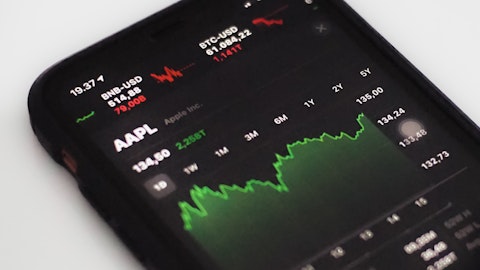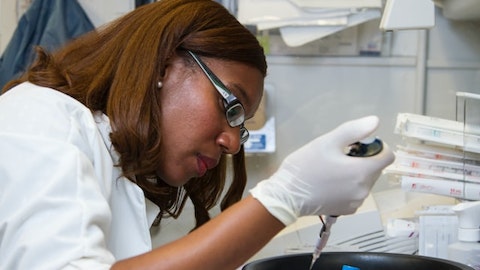Theravance Biopharma, Inc. (NASDAQ:TBPH) Q3 2023 Earnings Call Transcript November 7, 2023
Operator: Ladies and gentlemen, good afternoon. I’d like to welcome everyone to Theravance Biopharma’s Third Quarter 2023 Conference Call. During the presentation, all participants will be in a listen-only mode. A question-and-answer session will follow the company’s formal remarks. [Operator Instructions] Also, today’s conference call is being recorded. And now I’d like to turn the call over to Rick Winningham, Chief Executive Officer. Please go ahead, sir.
Rick Winningham: Good afternoon, and thank you for joining the Theravance Biopharma’s third quarter 2023 earnings results conference call. Turning to slide two, I’d remind you that this call will contain forward-looking statements that involve risks and uncertainties including statements about our development pipeline, expected benefits of our products, anticipated timing of clinical trials, regulatory filings and expected financial results. Information concerning factors that could cause results to differ materially from our forward-looking statements is described further in our filings with the SEC. On slide three. I’m joined today by Rick Graham our Head of Research and Development; Rhonda Farnum, Theravance’s Chief Business Officer; and Aziz Sawaf, our Chief Financial Officer.
Moving to slide four, throughout the year we communicated progress on several strategic objectives for the company. Mainly to grow YUPELRI while completing and disclosing the results of the PIFR-2 study, initiating and advancing our Phase 3 CYPRESS study and advancing – achieving non-GAAP profitability during the second half of the year subject to YUPELRIs continued growth. Based on our third quarter performance, we continue to make good progress against these objectives. Beginning with YUPELRI, our combined team achieved $58.3 million in total third quarter net sales, representing growth of 9% year-on-year, and the highest quarterly net sales results since launch. Highlights include another outstanding performance by our hospital-based commercial organization, continued growth in the retail channel, and further market share gains.
We completed our PIFR 2 study enrollment in the third quarter and continue to expect to share top-line data in January. In a new and exciting development, we’ve just learned that Viatris Phase 3 study of YUPELRI in Chinese patients with moderate to very severe COPD was positive, and that that data were consistent with the previous findings of YUPELRI’s strong efficacy. Our partners at Viatris plan to move forward with a registrational filing in China in mid-2024. As a reminder, COPD is a leading cause of morbidity and mortality in China with over 100 million individuals affected, and Theravance stands to receive development and sales milestones, as well as low double-digit royalties on sales in China and adjacent territories under our expanded 2019 agreement with Viatris.
Moving to ampreloxetine and CYPRESS, we continue to open sites globally during the quarter, and we presented two abstracts at the International Congress on Parkinson’s Disease and Movement Disorders in August, and we will present additional data later this month at the American Autonomic Society in Puerto Rico. Next on the financials, we reported a non-GAAP loss of $700,000 approximately during the quarter. Coming close to our objective of achieving non-GAAP profitability, this was driven by a combination of YUPELRI growth and effective expense management. We returned another $31 million through our capital returns program, bringing us to a total of $295 million since inception, and putting us in a position to return the final $30 million in the fourth quarter.
On slide five, I’d like to take a moment to level set how we see Theravance today. Theravance has become a streamlined organization focused on maximizing the value of two key assets. YUPELRI, a growing source of cash flows with a bright future, and ampreloxetine, a rare neurological asset roughly a year and a half from top-line data. Theravance is currently debt-free with no need to access the capital markets to realize the full potential of these assets. In short, we believe we embody a unique profile in biotech at a time when the capital markets have been challenging. As we complete the substantial return of capital program, pay down of debt, board enhancements and expense streamlining that the company undertook following the sale of our trilogy of royalty interest, management and the board continue to comprehensively review all elements of the business, the strategy, and opportunities to maximize shareholder value.
Now, turning to slide six, Rick Graham and I will cover ampreloxetine’s potential in MSA, beginning with the addressable patient population. We’ve discussed in the past MSA is a rare neurological disorder affecting 50,000 people in the United States, of which approximately 35 to 45,000 suffer from symptomatic nOH. While this represents a substantial opportunity on its own, we’re also exploring ways in which we can make ampreloxetine available globally, since our hope is to improve the lives of as many MSA patients suffering from nOH as possible, given the profound impact this condition can have on the quality of life of patients and their caregivers, and there are limited treatment options currently available. If you turn to slide seven, you can see that the number of MSA patients estimated to have symptoms of nOH increases by roughly a factor of five, if one includes Europe, Japan, and China.
Given the need that remains for patients worldwide, we are committed to exploring ways to reach patients outside the U.S. as well. On slide eight, I’d note that Theravance retains global rights to ampreloxetine, granted IP, extending to 2037 in the U.S. In addition, we received orphan drug designation earlier this year. As many of you know, orphan drug designation confers seven years of market exclusivity to a product, as well as exemption from user fees. However, it’s also particularly important when it comes to pricing. The Inflation Reduction Act mandates that Medicare negotiate price reductions for certain drugs with high spending after nine years of commercial availability for small molecules. Drugs with a single orphan designation, such as ampreloxetine, are excluded from this requirement, which protects their value and supports the investments made in their development.
Before I turn the call over to Rick Graham, I’d like to address the transition in R&D leadership we announced today. Rick will be leaving the company with Áine Miller taking over as head of development. Although he’ll be staying for several months to ensure a successful transition as we approach the completion of the PIFR-2 study study and the CYPRESS, with the CYPRESS study well underway, now is an ideal time to begin this transition. Over his tenure at Theravance, Rick built an exceptional development organization, established many of its key clinical capabilities. Theravance relies on for its success. And we’re thrilled to have Áine guide the organization through CYPRESS’s conclusion, ampreloxetine’s potential filing, and approval and beyond.
With her proven track record of strategic and regulatory leadership, Áine’s been ready to take on this role for some time, and she will be an exceptional head of development. With that, I’ll turn the call over to Rick to make some additional comments on ampreloxetine. Rick.
Rick Graham: Thanks, Rick. Let me begin on slide nine by providing some additional detail on the unmet need in MSA for patients with NOH, as well as why we believe we can quickly and successfully move ampreloxetine toward NDA filing and approval. First, it’s important to recognize that nOH symptoms are persistent upon sitting or standing, and without effective treatment, lead to deconditioning that can have lasting effects. Moreover, the combined effects of symptomatic nOH and MSA disease progression have a significant impact on quality of life over time. As we highlight here, studies evaluating the effects of nOH symptoms on patients’ quality of life consistently highlight a substantial negative impact, despite the availability and use of therapeutic intervention.
Currently approved therapies to treat orthostatic hypotension carry safety warnings for supine hypertension, which is an important side effect impacting use, especially amongst the many MSA patients that have pre-existing supine hypertension resulting from their disease. Ampreloxetine works differently than available therapies using a patient’s own norepinephrine, which we believe is why there was no impact on supine blood pressure in the phase three study 170 and no signal for supine hypertension in over 800 patients and healthy volunteers studied to date. In the 170 study, Ampreloxetine demonstrated a durable and clinically relevant treatment effect compared to placebo in MSA patients, as well as a broad and consistent effect on the six cardinal symptoms of nOH evaluated by the OHSA composite score.
If this efficacy and safety profile is replicated in the ongoing Phase 3 CYPRESS study, we believe ampreloxetine will bring compelling value to patients and caregivers. So let’s talk more about CYPRESS on slide 10. In the past, we’ve described ampreloxetine mechanism of action and why it’s particularly well suited to address the symptoms of nOH in MSA patient. Ampreloxetine works on intact peripheral nerves in MSA patients to raise endogenous norepinephrine levels with an approximate one and a half fold increase after four weeks of administration, as shown in our prior clinical trials. What’s of particular importance is the impact that ampreloxetine treatment showed on standing systolic blood pressure in study 170. Patients with neurogenic OH experience persistent decreases in blood pressure upon sitting or standing, which often leads to debilitating symptoms, which impact their sense of independence and their quality of life.
As a norepinephrine reuptake inhibitor, ampreloxetine restores vascular tone and has increased blood pressure by increasing the endogenous norepinephrine, thereby impacting symptoms with a reduced potential to impact blood pressure during the resting state. After 22 weeks of treatment in study 170, ampreloxetine was able to prevent blood pressure decrease in patients remaining on therapy where those entering the randomized withdrawal period on placebo saw a marked decrease in blood pressure after three minutes of standing. Finally, in the same study, patients receiving ampreloxetine experienced an improvement of 1.6 points relative to placebo on the OHSA symptom composite score, which was nominally statistically significant as well as clinically significant.
Taken together, we believe CYPRESS’s potential for technical success lands at the upper end of the range of studies conducted in rare and neurological diseases in recent years. Moving to the bottom of the slide, I’ll briefly recap ampreloxetine’s regulatory outlook. As a reminder, the Phase 3 study 170 included patients with MSA, Parkinson’s disease, and pure autonomic failure. Upon completion of study 170, the company held a type C meeting with the FDA to discuss the pre-specified analysis of MSA patients. The FDA agreed with both our interpretation of the 170 study results and the proposal to use OHSA composite score as a primary endpoint for CYPRESS. In addition, given the results of 170 and the seriousness of nOH and MSA, the FDA agreed that we could meet the substantial evidence standard required for full approval with one additional successful well-controlled trial.
This is CYPRESS. Finally, we believe it’s important to understand that we have already completed the substantial body of work necessary to file an NDA for ampreloxetine should CYPRESS be successful. Thus, we believe that the time from top line disclosure to filing a potential approval could be expedited. Before I turn it over to Rhonda, I’d like to say a few words about my upcoming departure from the company. I’m committed to ensuring a seamless transition to the new head of development, Áine Miller, and I’m genuinely thrilled for Áine and fully support her appointment. I’ll continue with the company through early 2024 with several deliverables, including the readout of the PIFR 2 top line results and capitalizing on the current momentum we have with CYPRESS, while then transitioning the accountability to Áine.

Thank you to Rick Winningham for his trust and mentorship, to the colleagues and friends I’ve worked with over the past eight years, and to our external stakeholders for your support and confidence in the company. I’m optimistic about the path ahead and the future success of Theravance Biopharma. So now I’ll turn the call over to Rhonda to discuss YUPELRI.
Rhonda Farnum: Thanks, Rick. Let’s begin on slide 12 with a snapshot of YUPELRI’s value to Theravance. As I’ll cover in greater detail in a moment, YUPELRI enjoyed another successful quarter of growth, bringing its last 12-month sales to approximately $216 million. As we always note, Theravance is entitled to 35% of YUPELRI’s profits through our collaboration with Viatris. In addition to the direct contribution of YUPELRI profits in the U.S., we also stand to achieve potential YUPELRI value through milestones and royalties through our relationship with Viatris. One important source of this value is in China and adjacent territories, where Viatris just completed a successful Phase 3 registration enabling study. This study, for which we plan to make additional details available shortly, demonstrated YUPELRI’s strong lung function benefits and the advantages of LAMA therapy as foundational for the maintenance treatment of COPD.
On the basis of these results, our partners at Viatris plan to file for approval in China in mid-2024. We stand to receive up to $45 million in milestone payments associated with YUPELRI monotherapy, as well as low double-digit tiered royalties on sales in these territories. Turning to slide 13, you can see the continuation of YUPELRI’s net sales performance with total sales of 9% year-on-year and 6% quarter-on-quarter to $58.3 million. The advances implied 35% share of net sales for YUPELRI during the third quarter of 2023 was $20.4 million. This represents the highest level of sales achieved since launch, benefit from growing demand generation in both the hospital and community settings. We believe that this is a direct result of our strategic initiatives, including educating on concomitant use of YUPELRI with the LAMA, transition of care coordination, and fulfillment support, which we see impacting important key performance indicators internally.
On slide 14, I’ll cover our hospital performance, which remains strong and consistent relative to previous quarters. As we continue to note, the hospital point of care is a strategic catalyst for the higher persistency community use of YUPELRI, despite accounting for a smaller percentage of the total business. Many patients with COPD experience an acute respiratory episode serious enough to require a trip to the hospital, at which time caregivers may consider switching to or adding YUPELRI as part of a treatment regimen. Thus, our ability to generate demand in the hospital setting has a meaningful and growing impact on subsequent YUPELRI prescribing in the community setting. As you can see on the right-hand side of the graph, two to three hospital doses sold represents the highest quarterly volume of YUPELRI units sold since launch and increased 41% year-over-year.
Turning to slide 15, you can see that our hospital performance translated into another improvement in YUPELRI’s overall share of the hospital-based long-acting NEB market. Year-over-year, we improved nearly three percentage points to 16.1% overall. As we have indicated in the past, this metric reflects the progress we are making, both in terms of the number of accounts that have placed YUPELRI on formulary, as well as our team’s success in supporting all-in protocol implementation and therapeutic interchange adoption. These initiatives are the foundation of our transition of care strategy, and we’ve achieved a higher market share in those hospitals where we have successfully implemented these programs. Consistent with past quarters, the majority of patients receiving YUPELRI in the hospital during the quarter received a prescription at discharge to continue YUPELRI in the community setting.
Turning to our market share development in the community setting, on the right-hand side of the slide, it is much the same story. At 30.2%, quarterly YUPELRI long-acting NEB market share represented an all-time high and an improvement of over a percentage point sequentially. Picking up on this performance on slide 16, the combined efforts of Theravance and Viatris drove another solid performance in the retail channel, which represents approximately 40% of overall community volume. As depicted on the left-hand side of the slide, total prescription growth at retail accelerated slightly to 9% sequentially and 30% year-on-year. While prescriptions filled at retail remain our best real-time metric to gauge total community demand trends, durable medical equipment or DME fulfillment still accounts for a larger portion of overall community volume.
But our ability to report trends lags a quarter behind in reporting due to the Medicare Part B adjudication process. As such, retail activity alone may not be indicative of that sales performance in any given quarter due to a number of factors, including inventory, which we’ve experienced from time to time. Turning to our new-to-product performance on the right-hand side, volumes declined 4% quarter-on-quarter but grew 40% year-on-year. While overall YUPELRI sales exhibit only modest seasonality, this particular figure tends to fluctuate more significantly due to the seasonal factors as we have seen with other respiratory therapy trends in the market, such as exacerbations frequency, which in turn correlates with hospital and doctors’ office visits and potential therapy modifications.
Based on the continued success of our recently introduced commercial initiatives, as well as internal performance indicators, we would expect to see continued strong results in the fourth quarter. We also remain excited about the potential growth opportunities for the overall YUPELRI brand going into 2024 and beyond. The Gold Report treatment recommendation of LAMA therapy being foundational, in addition to our concomitant use messaging, provides continued opportunities for YUPELRI to be considered as a switch or add-on therapy within the existing long-acting nebulized market. Also, there remains a sizable population of COPD patients who could benefit from YUPELRI, including those inappropriately using short-acting agents as maintenance therapies, as well as patients who remain uncontrolled on handheld-only maintenance regimens, with the latter patient population being the focus of our PIFR-2 study.
We continue to project that we will share the top-line results of the PIFR-2 study in January, and we are hopeful that a positive result will open further growth opportunities for the product here in the U.S. With that, I will turn the presentation over to Aziz to review the financials. Aziz?
Aziz Sawaf: Thanks, Rhonda. Beginning on slide 18, I’d like to start by discussing how our transformation in recent years and disciplined approach to capital allocation are driving today’s financial performance. First, even through our challenging COVID environment, we’ve been able to contribute to YUPELRI net sales growth each year since 2020. Second, we’ve taken significant action to reduce costs. By focusing our portfolio and reducing headcount, we’ve achieved a 70% reduction in operating expenses, including share-based compensation, going from $370 million in 2020 to a projected $115 million in 2023. Third, we eliminated our debt. In 2022, the company monetized its trilogy interest for $1.1 billion, using the proceeds to achieve a debt-free balance sheet and initiate, and now largely complete, a program to return $325 million of capital to shareholders via share buyback, which has reduced our share count by approximately 34%.
By implementing these strategies, we’ve been able to focus our capital allocation on two high-value initiatives. Growing YUPELRI and progressing ampreloxetine towards a significant value inflection point. Turning to the quarter, slides 19 and 20 cover our detailed financial results, which came in better than expectations on the expense side. I’ll cover the highlights on slide 21. Starting with collaboration revenue, we reported $15.7 million, recognized through our Viatris partnership, representing an all-time high. Regarding expenses, shortly after the elimination of research in late Q1, we introduced an initiative aimed at streamlining our G&A organization. This initiative led to a reduction in G&A expenses and was the largest driver behind the overall decrease in spend from Q2 to Q3.
We remain dedicated to assessing additional cost-cutting initiatives within G&A and maintaining a disciplined approach to expense management. In the quarter, we reported a GAAP loss of $9 million and a non-GAAP loss of $0.7 million, with cash burn excluding cash outflow for share buybacks of $2.6 million. It’s important to note the main distinction between GAAP and non-GAAP is that the GAAP metric incorporates non-cash share-based compensation. Going forward, we’ll begin highlighting both GAAP and non-GAAP results so that investors can gain a better understanding of the impact of both our non-GAAP metric, which can be used as a proxy for cash flow, and overall GAAP profitability, which takes into account the share-based compensation. During the quarter, we bought back approximately $31 million worth of shares and ended the period with $134 million in cash and equivalents.
We have approximately $30 million remaining on our capital return program, which we expect to complete by year end. These repurchases reduced our share count by $3.2 million during the period, leaving us with approximately $51 million of shares outstanding as of quarter end. Moving to slide 22, we’ll comment on our financial guidance. For R&D expenses excluding share-based comp, we are currently tracking towards the lower end of guidance of $35 million to $45 million. In Q4, we expect a slight increase in R&D expenses relative to Q3 actuals due to higher projected enrollment and site initiation for the CYPRESS study. For SG&A expenses excluding share-based comp, we are trending towards the upper end of our guidance range of $45 million to $55 million.
We anticipate Q4 SG&A expenses to be relatively flat when compared to Q3. As discussed in the Q&A section of our previous earnings call, one of the key factors influencing our operating expense trend is the change in the proportion of allocated overhead. This change is a result of our decision to eliminate research earlier this year, which has led to a lower proportion of overhead allocated to R&D and a higher proportion allocated to SG&A. For total expenses excluding share-based comp, we are now trending below the midpoint of guidance of $90 million. We expect to generate non-GAAP profitability in Q4, which will be primarily driven by the expectation of increased net sales from YUPELRI. And from a GAAP perspective, we expect to improve on the $9 million loss in Q3, driven again by increased net sales and an expected income tax benefit due to the filing of our 2022 U.S. federal income tax return in October.
To conclude, on slide 23, I’ll provide an update on our potential to earn milestones on global net sales of TRELEGY. GSK delivered another strong quarter of growth with quarterly and year-to-date net sales reaching $675 million and $2 billion respectively, up 22% and 25% when compared to the same period a year ago. To achieve our first $50 million milestone in 2023, TRELEGY would need to re-examine its net sales to reach $2.9 billion for the year, which based on the Q3 results we now believe is unlikely. Nonetheless, with the results achieved year-to-date that have demonstrated continued sales growth, we believe we are well positioned to attain milestone payments in 2024 and beyond, as the first $25 million milestone for 2024 is also set at $2.9 billion and the higher $50 million milestone at $3.2 billion.
As a reminder, the milestones starting in 2024 are not cumulative. For both milestones to be achieved in 2024, we would only receive a total of $50 million, not $75. With that, I’ll turn the call back to Rick for closing remarks. Rick?
Rick Winningham: Thanks, Aziz. On slide 26, I’ll finish by summarizing our intentions in the context of how we began. As we approach the end of 2023, our highest operating priorities are to continue to maximize the value of YUPELRI by continuing with our growth initiatives and taking full advantage of PIFR-2 should we achieve a positive outcome. Simultaneously, we’ll work hard to bring CYPRESS to a successful conclusion while ensuring as many patients as possible have access to ampreloxetine, should the results support regulatory approvals. We look forward to achieving milestones and royalties related to both TRELEGY and YUPELRI in the future. We’ll do this by keeping a sharp eye on expenses and managing the business as efficiently as possible. As always, we remain committed to the best path forward to drive value for our shareholders. I thank you for your time, your attention, and now I’ll turn the call back over to the operator for questions.
See also 10 Undervalued Semiconductor Stocks To Buy Now and 10 Best Electric Utility Stocks To Buy Now.
Q&A Session
Follow Theravance Biopharma Inc. (NASDAQ:TBPH)
Follow Theravance Biopharma Inc. (NASDAQ:TBPH)
Operator: Thank you, sir. [Operator Instructions] Our first question comes from David Risinger with Leerink Partners. You may proceed.
David Risinger: Yes, thanks very much, and congrats on the updates. I have two questions, please. First, regarding ampreloxetine CYPRESS study, could you please remind us about the process after you enroll the last patient into the openly labeled portion of the study in the second half of 2024, and when we should expect top-line efficacy results? And then separately, could you provide some more detail on the YUPELRI-XUS [Ph] economic opportunities and potential timing? Thanks very much.
Rick Winningham: Sure, David. Rick, you want to kind of just outline verbally for David the open label? And randomized withdrawal?
Rick Graham: Yes, sure. Yes, happy to do it. Thanks for the question, David. So as a reminder, the study design is a randomized withdrawal design for CYPRESS, similar to the 170 study with some small differences in duration of the open label and randomized withdrawal period. But to answer your question, what happens after open label is that patients get randomized to either remain on ampreloxetine or go to placebo, and that is an eight-week duration for the open label period. So once they get through that eight weeks, then we will start working on cleaning the data and working toward a top-line result. Now, keep in mind, we’re still early in the study conduct process, and we continue to add sites. But as Rick said in his opening remarks, we’re approximately a year and a half from top-line data is our estimate today.
Rick Winningham: Dave, I think your next question was on YUPELRI economics.
David Risinger: Yes, ex-U.S. So there was a –Yes, that would be, ex-U.S. economics.
Rick Graham: Yes, I can take that one, David. Okay. So yes, there’s two components of the ex-U.S. economics, the first of which, since we just highlighted the China opportunity and the fact that Viatris were going to file the application next year. The economics are up to 52.5 million in milestones for development and sales. Now, of that 52.5, 45 is related to the monotherapy. So the 45 is in play right now. Of the 45 and this will be outlined in our 10-Q when we file in a couple days, 7.5 of that is related to a regulatory approval milestone. And the rest of the 37.5 relate to sales milestones, which we don’t break out currently. So the next milestone for the China opportunity would be seven and a half if the China regulatory authorities approve the product.
And then in addition to the development and sales milestones, we have low double-digit tiered royalties in China. Outside of China, which I think is probably going to be a bit of a smaller opportunity, we’re actually already getting low double-digit to mid-team royalties. We have a little — we had one recognized Q4 of last year. We have a tiny bit each quarter, but they’re pretty much immaterial. I would focus most of the modeling on the China opportunity.
David Risinger: Great. Thank you.
Operator: Thank you. One moment for questions. Our next question comes from Douglas Tsao with H.C. Wainwright. You may proceed.
Douglas Tsao: Hi. Good afternoon. Thanks for taking the question. So just maybe starting on YUPELRI, we saw this quarter sort of a new high in terms of your hospital market share at 16.1%. But if I look at the sort of hospital sales in terms of doses, it looks like it was relatively flat to the first quarter. So can you maybe just help us understand some of those dynamics? Because if I look at the share versus the first quarter, you’re up like 120 basis points. So, some really nice performance there. So just what’s going on in the overall market?
Rick Winningham: Rhonda, you want to describe the Q1 and then Q3?





